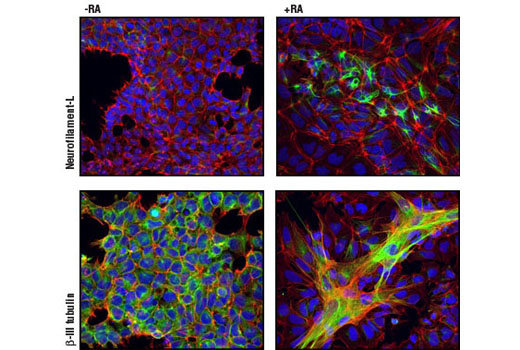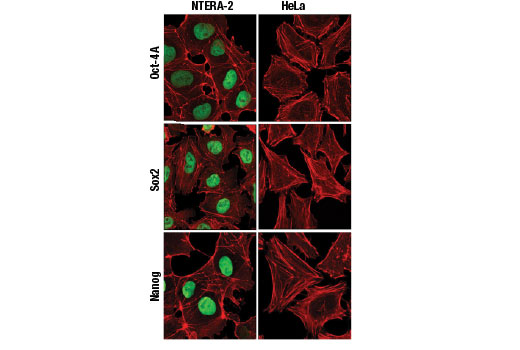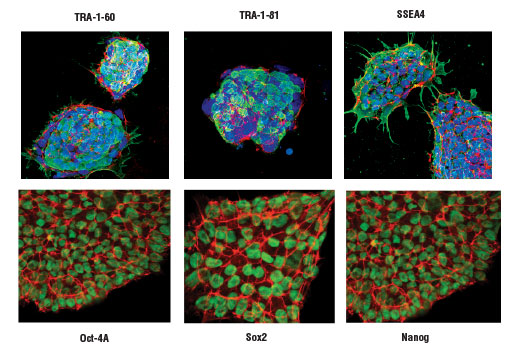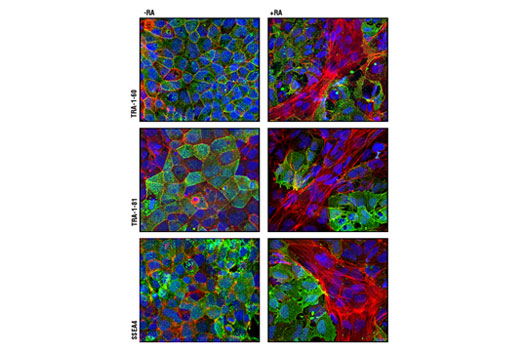| Kit Includes | Quantity | Applications | Dilution | Isotype |
|---|---|---|---|---|
| Oct-4A (C30A3) Rabbit mAb | 100 tests | IF-IC | 1:200 | Rabbit IgG |
| Sox2 (D6D9) Rabbit mAb | 100 tests | IF-IC | 1:200 | Rabbit IgG |
| Nanog (D73G4) XP® Rabbit mAb | 100 tests | IF-IC | 1:200 | Rabbit IgG |
| SSEA4 (MC813) Mouse mAb | 100 tests | IF-IC | 1:200 | Mouse IgG3 |
| TRA-1-60(S) (TRA-1-60(S)) Mouse mAb | 100 tests | IF-IC | 1:200 | Mouse IgM |
| TRA-1-81 (TRA-1-81) Mouse mAb | 100 tests | IF-IC | 1:200 | Mouse IgM |
Applications Key: IF-IC=Immunofluorescence (Immunocytochemistry)
Description
The StemLight® Pluripotency Antibody Kit contains a panel of antibodies for the detection of proteins that are specifically expressed in human pluripotent cells. The kit can be used to track the pluripotent potential of human embryonic stem (ES) or induced pluripotent (iPS) cells. The loss of these markers indicates a loss of pluripotency or differentiation of the culture. The kit components are pre-optimized for parallel use in immunofluorescent analysis. Enough reagents are provided for 100 assays based on a working volume of 100 µl.
Storage
Background
Pluripotency is the ability of a cell to differentiate into cell types of the three germ layers, the endoderm, ectoderm and mesoderm. It is a property shared by embryonic stem cells, embryonic carcinoma and induced pluripotent cells.
Oct-4, Sox2 and Nanog are key transcriptional regulators that are highly expressed in pluripotent cells (1). Together they form a transcriptional network that maintains cells in a pluripotent state (2,3). Over-expression of Oct-4 and Sox2 along with Klf4 and c- Myc can induce pluripotency in both mouse and human somatic cells, highlighting their roles as key regulators of the transcrip- tional network necessary for renewal and pluripotency (4-5). It has also been demonstrated that overexpression of Oct-4, Sox2, Nanog and Lin28 can induce pluripotency in human somatic cells (6). Upon differentiation of pluripotent cultures, expression of Oct-4, Nanog and Sox2 is downregulated.
SSEA4, TRA-1-81 and TRA-1-60 antibodies recognize antigens expressed on the cell surface of all pluripotent cells. SSEA4 recognizes a glycolipid carbohydrate epitope (7). TRA-1-60(S) and TRA-1-81 antibodies recognize different proteoglycan epitopes on variants of the same protein, podocalyxin (8). These epitopes are neuraminadase sensitive and resistant, respectively. Reactivity of SSEA4, TRA-1-81 and TRA-1-60 antibodies with their respective cell surface markers are lost upon differentiation of pluripotent cells, corresponding with a loss of pluripotent potential (9).
- Looijenga, L.H. et al. (2003) Cancer Res 63, 2244-50.
- Pesce, M. and Schöler, H.R. (2001) Stem Cells 19, 271-8.
- Pan, G. and Thomson, J.A. (2007) Cell Res 17, 42-9.
- Takahashi, K. and Yamanaka, S. (2006) Cell 126, 663-76.
- Okita, K. et al. (2007) Nature 448, 313-7.
- Yu, J. et al. (2007) Science 318, 1917-20.
- Henderson, J.K. et al. (2002) Stem Cells 20, 329-37.
- Draper, J.S. et al. (2002) J Anat 200, 249-58.
- Schopperle, W.M. and DeWolf, W.C. (2007) Stem Cells 25, 723-30.
Background References
Trademarks and Patents
使用に関する制限
法的な権限を与えられたCSTの担当者が署名した書面によって別途明示的に合意された場合を除き、 CST、その関連会社または代理店が提供する製品には以下の条件が適用されます。お客様が定める条件でここに定められた条件に含まれるものを超えるもの、 または、ここに定められた条件と異なるものは、法的な権限を与えられたCSTの担当者が別途書面にて受諾した場合を除き、拒絶され、 いかなる効力も効果も有しません。
研究専用 (For Research Use Only) またはこれに類似する表示がされた製品は、 いかなる目的についても FDA または外国もしくは国内のその他の規制機関により承認、認可または許可を受けていません。 お客様は製品を診断もしくは治療目的で使用してはならず、また、製品に表示された内容に違反する方法で使用してはなりません。 CST が販売または使用許諾する製品は、エンドユーザーであるお客様に対し、使途を研究および開発のみに限定して提供されるものです。 診断、予防もしくは治療目的で製品を使用することまたは製品を再販売 (単独であるか他の製品等の一部であるかを問いません) もしくはその他の商業的利用の目的で購入することについては、CST から別途許諾を得る必要があります。 お客様は以下の事項を遵守しなければなりません。(a) CST の製品 (単独であるか他の資材と一緒であるかを問いません) を販売、使用許諾、貸与、寄付もしくはその他の態様で第三者に譲渡したり使用させたりしてはなりません。また、商用の製品を製造するために CST の製品を使用してはなりません。(b) 複製、改変、リバースエンジニアリング、逆コンパイル、 分解または他の方法により製品の構造または技術を解明しようとしてはなりません。また、 CST の製品またはサービスと競合する製品またはサービスを開発する目的で CST の製品を使用してはなりません。(c) CST の製品の商標、商号、ロゴ、特許または著作権に関する通知または表示を除去したり改変したりしてはなりません。(d) CST の製品をCST 製品販売条件(CST’s Product Terms of Sale) および該当する書面のみに従って使用しなければなりません。(e) CST の製品に関連してお客様が使用する第三者の製品またはサービスに関する使用許諾条件、 サービス提供条件またはこれに類する合意事項を遵守しなければなりません。



